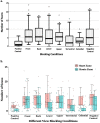What view information is most important in the homeward navigation of an Australian bull ant, Myrmecia midas?
- PMID: 36048246
- PMCID: PMC9734209
- DOI: 10.1007/s00359-022-01565-y
What view information is most important in the homeward navigation of an Australian bull ant, Myrmecia midas?
Abstract
Many insects orient by comparing current panoramic views of their environment to memorised views. We tested the navigational abilities of night-active Myrmecia midas foragers while we blocked segments of their visual panorama. Foragers failed to orient homewards when the front view, lower elevations, entire terrestrial surround, or the full panorama was blocked. Initial scanning increased whenever the visual panorama was blocked but scanning only increased along the rest of the route when the front, back, higher, or lower elevations were blocked. Ants meandered more when the front, the back, or the higher elevations were obscured. When everything except the canopy was blocked, the ants were quick and direct, but moved in random directions, as if to escape. We conclude that a clear front view, or a clear lower panorama is necessary for initial homeward headings. Furthermore, the canopy is neither necessary nor sufficient for homeward initial heading, and the back and upper segments of views, while not necessary, do make finding home easier. Discrepancies between image analysis and ant behaviour when the upper and lower views were blocked suggests that ants are selective in what portions of the scene they attend to or learn.
Keywords: Celestial cue; Familiar environment; Heading direction; Homeward navigation; Terrestrial panorama.
© 2022. The Author(s).
Conflict of interest statement
The authors declare that they have no conflict of interests.
Figures






Similar articles
-
Effect of large visual changes on the navigation of the nocturnal bull ant, Myrmecia midas.Anim Cogn. 2020 Nov;23(6):1071-1080. doi: 10.1007/s10071-020-01377-0. Epub 2020 Apr 8. Anim Cogn. 2020. PMID: 32270349
-
Compass cues used by a nocturnal bull ant, Myrmecia midas.J Exp Biol. 2017 May 1;220(Pt 9):1578-1585. doi: 10.1242/jeb.152967. Epub 2017 Feb 9. J Exp Biol. 2017. PMID: 28183865
-
The View from the Trees: Nocturnal Bull Ants, Myrmecia midas, Use the Surrounding Panorama While Descending from Trees.Front Psychol. 2018 Jan 25;9:16. doi: 10.3389/fpsyg.2018.00016. eCollection 2018. Front Psychol. 2018. PMID: 29422880 Free PMC article.
-
Experimental ethology of learning in desert ants: Becoming expert navigators.Behav Processes. 2019 Jan;158:181-191. doi: 10.1016/j.beproc.2018.12.001. Epub 2018 Dec 5. Behav Processes. 2019. PMID: 30529645 Review.
-
Steering intermediate courses: desert ants combine information from various navigational routines.J Comp Physiol A Neuroethol Sens Neural Behav Physiol. 2016 Jul;202(7):459-72. doi: 10.1007/s00359-016-1094-z. Epub 2016 Jun 3. J Comp Physiol A Neuroethol Sens Neural Behav Physiol. 2016. PMID: 27259296 Review.
Cited by
-
Route learning and transport of resources during colony relocation in Australian desert ants.Learn Behav. 2025 Jun;53(2):204-216. doi: 10.3758/s13420-024-00652-1. Epub 2024 Oct 22. Learn Behav. 2025. PMID: 39438403 Free PMC article.
-
Nest excavators' learning walks in the Australian desert ant Melophorus bagoti.Anim Cogn. 2024 May 24;27(1):39. doi: 10.1007/s10071-024-01877-3. Anim Cogn. 2024. PMID: 38789697 Free PMC article.
-
Directed retreat and navigational mechanisms in trail following Formica obscuripes.Learn Behav. 2024 Mar;52(1):114-131. doi: 10.3758/s13420-023-00604-1. Epub 2023 Sep 26. Learn Behav. 2024. PMID: 37752304 Free PMC article.
-
Desert ants (Melophorus bagoti) oscillate and scan more in navigation when the visual scene changes.Anim Cogn. 2025 Feb 20;28(1):15. doi: 10.1007/s10071-025-01936-3. Anim Cogn. 2025. PMID: 39979462 Free PMC article.
-
Desert Ant (Melophorus bagoti) Dumpers Learn from Experience to Improve Waste Disposal and Show Spatial Fidelity.Insects. 2024 Oct 16;15(10):814. doi: 10.3390/insects15100814. Insects. 2024. PMID: 39452390 Free PMC article.
References
-
- Batschelet E (1981) Circular statistics in biology. Academic Press, New York
MeSH terms
Grants and funding
LinkOut - more resources
Full Text Sources

